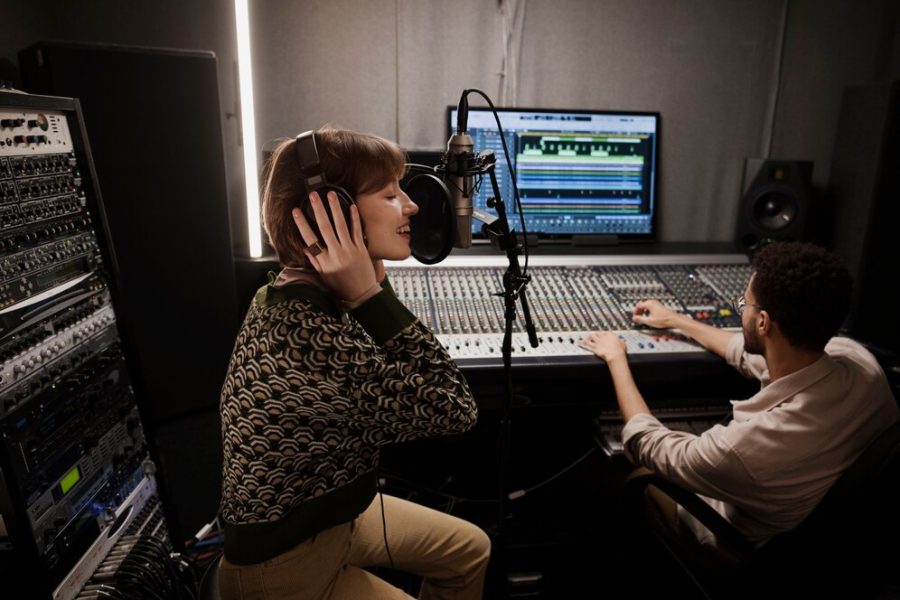In contemporary music production, balancing vocals in the mix plays a pivotal role in delivering a captivating final track. However, achieving the perfect blend of voices and mastering vocals can present challenges to even the most seasoned sound engineers.
Balancing Vocals: Core Concepts in Managing Vocal Levels
Understanding Vocal Balance
To understand vocal balance, one must consider the role of fundamental frequency and pitch correction in the mix. The goal of any mix is to achieve the fullest sound without overbearing elements. A balanced mix is critical in ensuring each vocal component has equal prominence and clarity. Human voices vary significantly in their ranges and timbres, dominating different areas of the frequency spectrum. Therefore, achieving a clear vocal sound requires a delicate balance of high and low frequencies, and meticulous use of EQ.
Enhancing Sound Through Audio Equilibrium
Audio equilibrium is as crucial in music production as the harmonizing vocals themselves. The best way to enhance your sound is by taking the dynamic range into account, from the lowest low end to the highest high end. By manipulating vocal levels, you may prevent certain parts of the mix from overshadowing others, achieving a balanced audio production. Above all else, a great vocal balance fosters smooth transitions from one vocal tone to another, avoids problematic frequencies, and maintains an even dynamic range across the frequency spectrum.
Harmonizing Vocals: Techniques and Tactics for a Clearer Blend of Voices
The Role of Vocal Levels in Achieving Perfect Harmony
In a harmonious mix, vocal levels play a significant role to ensure a clearer blend of voices. Nevertheless, balancing vocal levels can be tricky, especially when dealing with harmony vocals. It’s essential to avoid drowning out the main vocal with other voices in the mix. The art and science of mixing harmony, thus come into play to make sure there’s a balanced mix engineering across all voices.
Equalizing Vocals for a Balance in Tone and Texture
Equalizing vocals deals with the frequency range, pitch correction, and tone of each voice to create a proportional vocal mix. Achieving this requires a keen ear and a knack for identifying which vocal frequencies should be amplified or attenuated. Sound balance techniques such as EQ can add depth to your sound by distinguishing each voice in the mix without making the vocals sound like they’re in competition with each other.
Unfolding the Secrets of Sound Balance Techniques too Vocals In The Mix
Balancing Frequencies for a Balanced Audio Production
To achieve a balanced vocal mix may require mitigating problematic frequencies that hog unnecessary space in the audio. Sound balance techniques involve using EQ to filter out low-end rumble and dampen overly harsh high-end frequencies that can make your vocal recording unpleasant.
Vocal Clarity and Its Importance in the Mix
Vocal clarity brings the lead vocal to life without overpowering the other elements of the mix. It’s achieved through meticulous use of EQ, and dynamic processing techniques such as compression, helping to reduce the dynamic range while accentuating the main vocal’s defining characteristics. You may need some gain reduction and pitch correction to maintain vocal clarity.
Mastering the Mix: Precision, Skill, And Technique
The Role of Mixing Techniques in Creating Clear Vocal Sound
Great mixing techniques do more than just balance audio levels; they bring the music to life. Keeping your leads at the forefront and supporting vocals subtly in the background can let your main vocal shine while adding richness to the overall sound.
Studio Vocal Balance: The Key to Mastering Vocals
The key to mastering vocals in a studio setting lies in understanding the concept of studio vocal balance. This involves the precise use of compression, equalization, and mixing precision, ensuring that each voice contributes to the overall balance of the mix, without one vocal overpowering the other.

Achieving Studio-Grade Vocal Tonal Balance
Vocal Compression: A Key to Balanced Soundstage
Vocal compression is the tool for any vocal mix that endeavors to achieve a balanced soundstage. By controlling the dynamic range and not letting any part of the vocals become too loud or too soft, vocal compression helps maintain a consistent level of volume throughout your vocal chain.
Mixing Precision for a Proportional Vocal Mix – Techniques and Skills
Mixing precision is a requisite skill needed to create a proportional vocal mix. It’s about adding subtlety in your sound through automation and enhancements like reverb and delay, shaping each element in the mix to add depth and dimension.
Balancing vocals in the mix is a nuanced process requiring meticulous attention to details. With practice, patience, and the right techniques, you can make every vocal in your mix shine. Remember, the goal is not to make the vocals sound good on their own, but to make them sound better together.
To sum up, mixing vocals and achieving an optimal blend of voices isn’t a one-size-fits-all endeavor. It requires a sound understanding of a set of principles and the flexibility to apply these rules creatively. Indeed, every recording presents a new challenge and an opportunity to polish our mixing skills for vocals.

